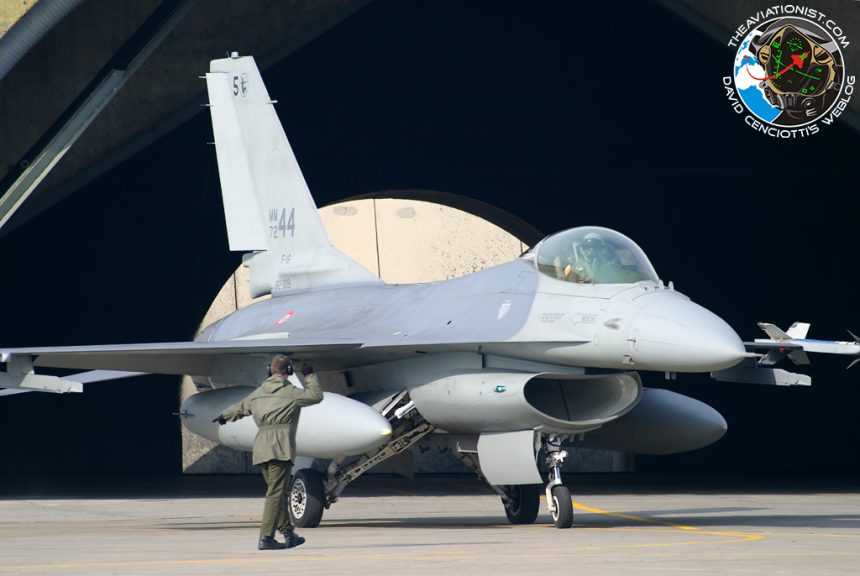In order to answer to the many questions people always ask me through the site about the Italian F-16s, together with Pierpaolo Maglio, one of the greatest Viper’s expert, I’ve prepared the following article dealing with the story of the F-16 in the Aeronautica Militare (Italian Air Force, ItAF).
THE ITALIAN AIR FORCE F-16s
Virtually begun on 1 Feb 2001, when the Italian MoD officially announced that the Lockheed Martin F-16 was the winner of the selection for an ad-interim fighter needed to fill the gap between the phase-out of the F-104 “Starfighter” (to be completed by 31 Dec 2004) and the achievement of the “Combat Readiness” of the first squadrons of Eurofighter “Typhoon” (expected by 2010), the “Peace Caesar” programme was inked on March 15th 2001 with the signature of two Foreign Military Sales Cases. One of these documents dealt with the leasing of 34 F-16s, the other was relative to all the activities needed to satisfy the main requirement of the ItAF: to have an efficient force of 24 aircraft able to perform at least two sorties on a daily basis.
The ItAF accepted the LM proposal that foresaw the purchase of a total 45,000 flying hours between 2004 and 2010, with all the necessary logistic support, of a fleet composed by 30 F-16A Block 15 ADF (Air Defense Fighter) upgraded with the “Falcon Up” and “Falcon 2020” modifications, 3 F-16B Block 10 OCU (Operational Capabilities Upgrade) and a single F-16B ADF. Another 4 twin seats airframes would have been delivered to the ItAF to be cannibalized for spare parts (actually, only 3 F-16A were logged, 2 resting in the GEA hangar in Trapani, 1 in Cervia). All the aircraft would have been equipped with the Pratt & Whitney F100-PW-220E engines and carry AIM-9 “Sidewinder” and AIM-120 “Slammer” air to air missiles. The leasing included also the conversion of 38 F-104 and Tornado F.3 pilots (among which 8 would gain the qualification of IP, Instructor Pilot; 10 would became Flight Lead and 20 would be qualified crews) that would be undertaken by the Arizona ANG and the training of 119 maintenance technicians, the 60% of whom would be instructors, performed by LM personnel at Fort Worth, Texas.
The arrival of the F-16 compelled the ItAF to a quick and quite unexpected restructuring. The 34 aircraft would be assigned to three Gruppi at that time flying the F-104, within two Stormi. Since 1998, there are five front line squadron within Divisione Area Caccia Intercettori (DACI, Fighter Interceptors Air Division) that is the main Command within the ItAF responsible for the management of the air defence assets: 9th Gruppo of the 4th Stormo at Grosseto, the 10th Gruppo of the 9th Stormo, located at Grazzanise, the 12th Gruppo of the 36th Stormo at Gioia del Colle, 18th Gruppo of the 37th Stormo at Trapani and 23rd Gruppo of the 5th Stormo at Cervia. The 9th Gruppo was already selected to receive the first Eurofighter at Grosseto while the 12th Gruppo was still operating the leased Tornado F.3 so the remaining three Gruppi were chosen to convert to the F-16. It was also decided to disband a Stormo, the 9th at Grazzanise at to transfer its Gruppo, the 10th at Trapani, thus concentrating at least two squadrons on the same base to ease the logistical support of the operative units.
The 5th Stormo was the first unit to retire the F-104S/ASA-M on December 27th 2002, when the 23rd Gruppo ceased its flying activity with the Starfighter moving most of the airworthy airframes to Grazzanise, Grosseto and Trapani. Following the departure of the 23rd Gruppo, Cervia airbase was closed so as to permit the beginning of the infrastructural works that the airport required in anticipation of the arrival of the first F-16s. While most of the pilots went to Tucson, Arizona, to join the 162nd FW of the Arizona ANG, a handful of crews were temporary absorbed by those Gruppi still flying the F-104, while waiting their turn to begin the training courses in the United States.
Unexpectedly, the works at Cervia airbase were longer than expected and, consequently, the first F-16s delivered on June 28th 2003, were “diverted” to the 18th Gruppo based at Trapani-Birgi airbase whose last four F-104 had been quickly moved to Grazzanise on April 22nd and whose refurbishment works had finished just in time to accommodate the new aircraft. Unfortunately, even if the Italian officials were waiting for five reconditioned aircraft (3 F-16B and 2 F-16A) only the three twin seats (with serials MM 7266, 7268, 7269) managed to arrive in Italy.
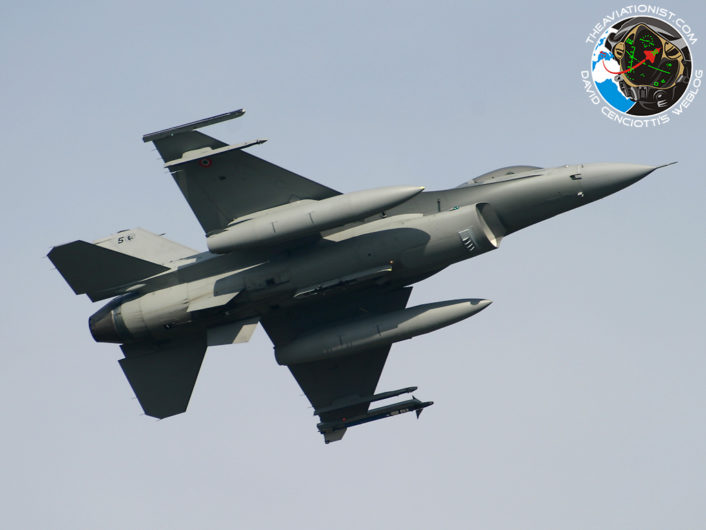
In fact as unveiled by the London Free Press on its website, on June 25th, during the first leg of the delivery flight from Hill AFB to Trapani with an intermediate stopover at Lajes, one the F-16A ADF (serialled MM7238, incidentally the first aircraft in the Italian markings rolling out at Hill on May 9th) piloted by the American pilot Lt. Col. Kurt Tek was compelled to perform an emergency landing in North Bay (Canada) after the engine went into a backup control mode which is a feature automatically activated when the primary control mode fails that compels the pilot to land the plane as soon as possible.
Three of the jets continued their flight while the other F-16A of the formation (MM 7246) escorted the aircraft of Lt. Col. Tek to a safe landing in the Canadian airport. After solving the problem these two F-16 were finally able to reach Trapani on July 2nd 2003.
The ceremony of the official delivery of the first five “Vipers” to the ItAF was held a few weeks later, on July 17th at Trapani. The aircraft were taken on charge by the 37th Stormo but wore the markings of both 18th Gruppo and 23rd Gruppo since this latter had most of the pilots qualified on the F-16 assigned to the Sicilian airbase until Cervia had completed its refurbishment works. With the recent delivery of the 23rd Gruppo aircraft to the 5th Stormo in their MOB only one Gruppo is still waiting for the transition to the new aircraft: the 10th Gruppo at Grazzanise.
At the beginning start of the new century the Aeronautica Militare Italian Air Force (AMI) still had 4 Squadrons flying vintage Starfightersthe F-104. The new interceptor, the Eurofighter Typhoon, or EF-2000 as it is called in Italy, was long to come (2010 was the estimated date for the combat readiness of the first Squadron) and the leasing of Tornado ADV from the RAF had been too much expensive while giving so few flyable airframes at any given time.
So the AMI chose to lease LM F-16 in a deal with USAF, LM and Pratt & Whitney.So the ItAF accepted the LM proposal that foresaw the purchase of a total 45,000 flying hours between 2004 and 2010, with all the necessary logistic support, of a fleet composed by 30 F-16A Block 15 ADF (Air Defense Fighter), 3 F-16B Block 10 OCU (Operational Capabilities Upgrade) still with small stabilizers and a single F-16B ADF. Another 4 twin seats airframes would have been delivered to the ItAF to be cannibalized for spare parts.
The lease was for 34 flyable airframes and 4 unflyable ones for the supply of spare parts.
Thirty of those airframes were F-16A Block 15 modified to ADF variant as used by ANG Squadrons. One was a twin seats B model block 15 with full ADF conversion while the remaining 3 were old twin seats block 10 airframes still with small stabilizers.
Before delivery all were reconditioned and repainted at Hill AFB. Reconditioning included Falcon Up and Falcon 2020 upgrades, Have Glass anti-radar paint and the Pratt & Whitney F100-PW-220E engines.
Unfortunately, even if the Italian officials were waiting for five reconditioned aircraft (3 F-16B and 2 F-16A) only the three twin seats (with serials MM 7266, 7268, 7269) managed to arrive in Italy. In fact, on Jun 25, during the first leg of the delivery flight from Hill AFB to Trapani with an intermediate stopover at Lajes, one the F-16A ADF (serialled MM7238, incidentally the first aircraft in the Italian markings rolling out at Hill on May 9) piloted by the American pilot Lt. Col. Kurt Tek was compelled to perform an emergency landing in North Bay (Canada) after the engine went into a backup control mode which is a feature automatically activated when the primary control mode fails that compels the pilot to land the plane as soon as possible. Three of the jets continued their flight while the other F-16A of the formation (MM 7246) escorted the aircraft of Lt. Col. Tek to a safe landing in the Canadian airport. After solving the problem these two F-16 were finally able to reach Trapani on 2 Jul 2003.
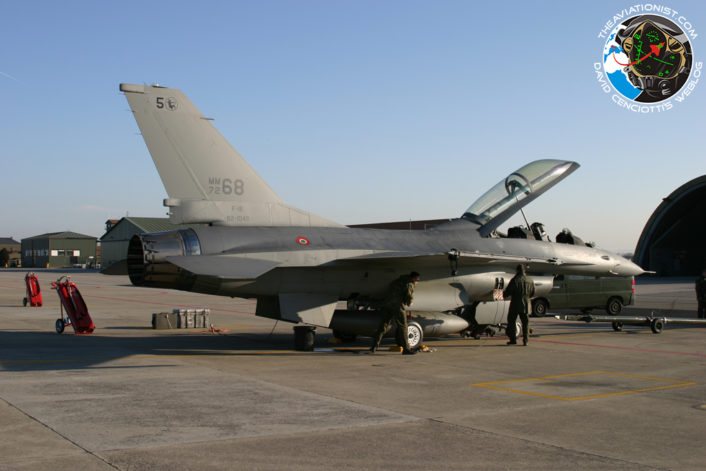
The ceremony of the official delivery of the first five “Vipers” to the ItAF was held a few weeks later, on 17 Jul at Trapani. The aircraft were taken on charge by the 37° Stormo but wore the markings of both 18° Gruppo and 23° Gruppo since this latter had been the first to retire the F-104 to receive the new aircraft and had most of the pilots qualified on the F-16 assigned to the Sicilian airbase because Cervia had not completed its refurbishment works needed to accommodate the aircraft yet. The works at Cervia airbase lasted much more than expected and, consequently, the first 5 F-16 delivered on 28 Jun 2003 to the ItAF were “diverted” to Trapani-Birgi airbase whose refurbishment works had begun on Apr 23 and had finished just in time to accommodate the new aircraft.
On 14 Nov 2003, 3 Lockheed Martin F-16 “Fighting Falcon” wearing the markings of the 23° Gruppo (Fighter Squadron) and belonging to the 5° Stormo of the Italian Air Force (ItAF) finally landed in their recently re-opened airbase at Cervia. The flight, under radio callsign “Veltro 01” (allocated to the Squadron Commander Lt.Col. Fabrizio Majerna who was piloting one of the fighters) landed in Cervia around 12:55 Local Time after a flight lasted more than three hours that brought them from their operating airbase of Trapani, in Sicily, to their home located along the Adriatic coast. The 5th Stormo at Cervia, together with the 37° Stormo at Trapani, had the task to defend the Italian airspace with the “gap-filler” F-16 until the first Eurofighter Typhoon squadrons will achieve full combat readiness in 2010.
The “Veltro 01” mission had a particular meaning for many reasons. It not only celebrated the return of the 23° Gruppo to its traditional airbase but showed how modern aircraft can introduce significant training advantages in a modern air force: before landing in Cervia, exploiting the endurance of the new aircraft, the three crews of the “Veltro 01” were able to engage a training area located above central Italy and perform several simulated air-to-air interceptions; something really unbelievable in the “Starfighter era” when the scarce endurance of the F-104 forced the pilots to fly shorter missions.
On 27 Dec 2002, the 23° Gruppo had been the first active unit within the Aeronautica Militare Italiana ceasing its flying activities with the F-104S/ASA-M in anticipation of the arrival of the first F-16s. In the intentions of the Italian Air Force was in fact that squadron destined to receive the first F-16s on delivery by Lockheed Martin. However, Cervia needed a runway renewal and other infrastructural works to be able to host the new aircraft. From November 2003 the 5° Stormo in Cervia got 2 of the twin seats: the only block 15 and one of the block 10. Later the block 10 moved back to Trapani and the 23° Gruppo of the 5° Stormo fleet was set at roughly ten airframes including the block 15 twin seats. All the other airframes were allocated to Trapani where, sadly, 5 ADF have gone lost so far (2 in a collision, one due to bird strike, one due to a broken gear and one due to a lightning; by luck all pilots safely ejected).
Three Gruppi within the ItAF have been equipped with the 34 aircraft, 30 F-16 ADF (Air Defense Fighter) and 4 F-16B Block 10 OCU (Operational Capabilities Upgrade), purchased under the “Peace Caesar” programme, in the following months: 23° and 18° squadron aside, the 10th Gruppo also received the “Viper” when it ceased the flying activities with the F-104 in the 2004 and moved from Grazzanise to Trapani to join the locally based 37° Stormo.
These 34 aircraft have been used to convert 3 fighter Squadrons from F-104S-ASAM: the 23rd Gruppo of the 5th Stormo in Cervia (North East coast of Italy), the 10th and the 18th of the 37th Stormo in Trapani (on the western tip of Sicily Island). Delivery started in June 2003.
From November that year the 5th Stormo in Cervia got 2 of the twin seats: the only block 15 and one of the block 10. Later the block 10 moved back to Trapani and the 23rd Gruppo of the 5th Stormo fleet was set at roughly ten airframes including the block 15 twin seats.
All the other airframes were allocated to Trapani where, sadly, 5 ADF have gone lost so far (2 in a collision, one due to bird strike, one due to a broken gear and one due to a lightning; by luck all pilots safely ejected).
For three years all aircraft only had Wing insignias painted on a small trapezium on the top of the tail with no Squadron markings at all. This trapezium looks different in colour since it is the only part of the airframe non covered with Have Glass paint. Then, in 2006, the 23rd° Gruppo got permission to paint a Greyhound on the tail of one ADF. Later all the fleet in Cervia got the Greyhound and those in Trapani followed soon applying their Squadron marking as wellon the rudder as well.
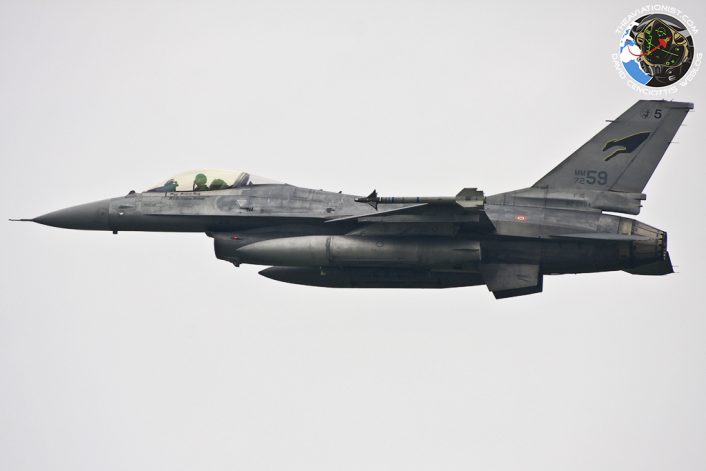
Since aircraft are officially assigned to GEA (Air Maintenance Group) and used by both Squadrons in Trapani on a pool basis, until summer 2008 only 4 of the Trapani F-16s from those in Trapani were painted with Squadron markings (2 from each Squadrons). The 10th 10° Gruppo ones got the preaching horse and the SPADES pike on both the sides of the air intake while a big black X (ancient-Roman number for 10) is was painted on the rudder.
The 18th ° Gruppo airframes got the checkerboardchecks on rudder (unfortunately in black and not in the bright green used by F-104s) and 3 chevrons (STRALI) on each side of the air intake.
Starting from Summer 2008 only two aircraft from those in Trapani were kept with the markings of a single Squadron: MM7255 for the 18th Gruppo and MM.7261 for the 10th Gruppo as depicted in this decal sheet. All the other airframes got markings from both Squadron: the 10th Gruppo on one side of the tail and the 18th Gruppo on the other (see also: Italian F-16s get new tail markings).
Since at Cervia there is only one Squadron, all aircraft got and kept the black Greyhound on the tail.
Cervia F-16s are moved from Cervia to Trapani only when in need of repairs are needed (engines are overhauled in Cervia while some other systems are repaired in Trapani) but those allocated to the Cervia’s 23rd Gruppo have never mixed with those in Trapani. For this reason, after so many years spent in such a different environment, aircraft assigned to each base look so different today.
In fact Trapani Air Base is on a small peninsula with the sea on the front and a salty lake on one the Western side. Since the aircraft are not recovered inside HAS (Hardened Shelters) at the base, sun and very salty air almost completely removed camouflaged gray paint from the aircraft that now are almost in aluminium overall since the Have Glass paint is the same colour of aluminium powder.
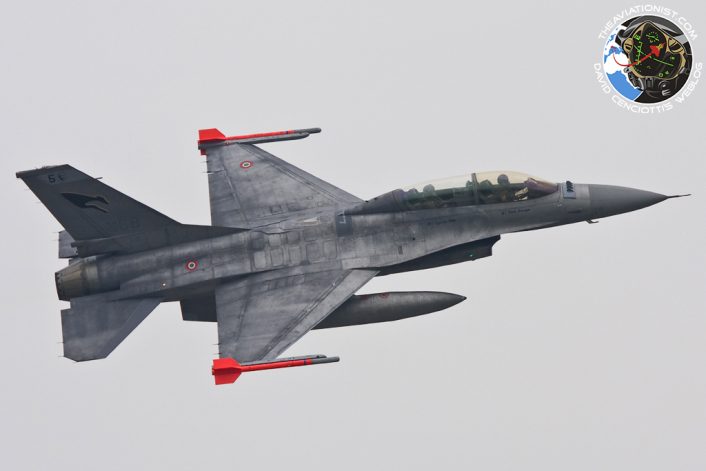
Instead, aircraft in Cervia have plenty of shelters to protect them from the sun and salt is not such an issue in the Cervia airbase since it is not exactly on the beach. Consequently, F-16 ADF from Cervia show just a little paint chipping and aircraft are still in gray camouflage. The lighter shade of gray just happens to have collected lot of dirt and grease over the years and now looks much darker.
EXTERNAL STORES
Italian Vipers are used in air defense mission only so there are no bombs or rockets in their armament. On the tip they usually carry the AIM-120 but AIM-9L can be used as well, while during training missions an ACMI pod is used.
On the external under wing pylons you can find AIM-9L, AIM-120 or a radar pod called AMD pod. These pods are similar to a Sidewinder missile’s body (but without the front wings), are painted in fluorescent-orange and are used to increase the radar signal of the plane when needed.
The middle wing pylons are usually not used but, when attached, they can be used for additional missiles or (more often) for a travel pod.
The inner wing pylons are almost always fitted with 370 US Gal tanks, these are removed very seldom since most of the missions are flown with tanks on.
The centreline pylon can be used to hang a 300 US Gal tank (rarely seen in the last few years) or for the baggage pod.
SPECIAL MARKINGS
The first Special Marking for the Italian Viper was painted during TLP (NATO Tactical Leader Program) course at Florennes AB in Belgium were a few F-16 from the 37th Stormo were deployed the very day of the final match.
On July 9th 2006 Italy won the Soccer World cup over French and the crew painted the cup along with 4 golden stars (one for each championships won by Italy) on the tail of the Vipers much to the disappointment of their French colleagues! Aircraft involved were MM 7261 and MM 7250 and they also got a big Italian flag on the right side of the front fuselage.
However these special markings didn’t last long.
The first truly Italian Special Colour Viper has been MM 7251 from the 5th Stormo / 23rd Gruppo. The occasion was the celebration for the 90th anniversary of the birth of the 23rd Gruppo in 2008. Airframe MM7251 was painted in Cervia in the second week of June 2008 and unveiled to the public during the 20th June Spotter Day at the control of the 5th Stormo Wing Commander.
This special colour is all dedicated to the 23rd Gruppo, his Greyhound and his oldest flight (the 71st Squadriglia which has an octopus in its insignia) while there is no sign of the Diana, the Wing emblem. This special colour is the brainchild of Giuliano Lazzari and Fabio Orlando while the main painter has been Lgt. Gilberto Maffessanti whose name is painted under that of the Squadron commander on the canopy sides.
Flat water based colours has been use to paint the F-16, several layers were needed to cover the underside paint that has not been removed. Colours used were RAL 7019 Anthracite Gray and RAL 7040 Window Gray. Although I had the opportunity to handle the paint bottle, I wasn’t able to find any reference for the yellow colour used. You can use the photos printed in this sheet to figure out the exact shade.
Names FiFi and FùFù on the paws of the two dogs are not related to any real pet but come from a joke between the two painters working on the dogs on each side of the fuselages.
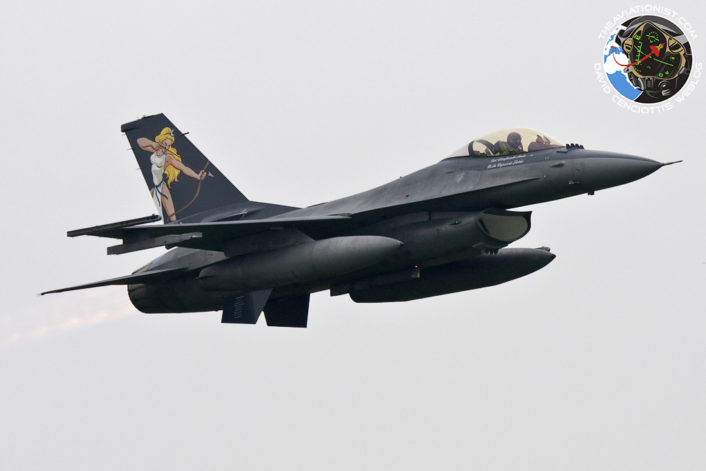
To protect the water-based colours Lgt. Maffessanti sprayed over a coat of glossy protective paint, something very similar to the Future used by modellers!
Regardless of the protective paint some chipped paint was already visible on 20th June on the IFF “bird slicer” antennas in front of the cockpit. This chipping was probably caused by the part not being perfectly wiped clean before painting.
Chipping was still there for the main event of 22nd June when the aircraft was flown by the 23rd Squadron commander in front of hundreds of veterans.
The problem was rectified in the following weeks when a couple of 370 US gal tanks were also painted with the same colours to fit MM7251.
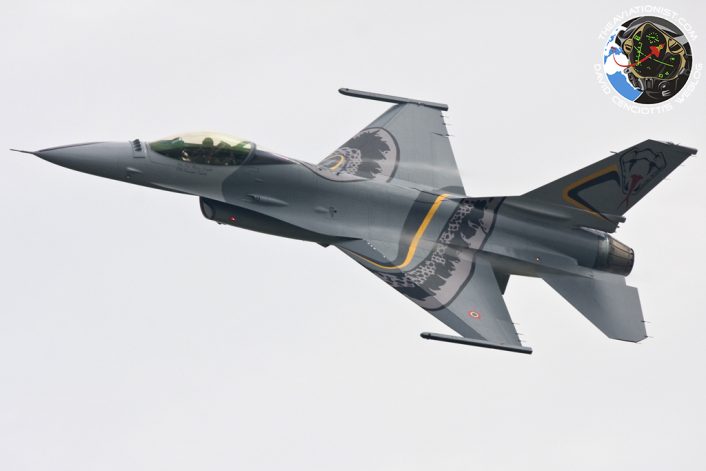
Missiles can be fitted to this Special Colour plane since it is now used for its operational missions keeping its special paint at least until October 2008, but please note that until now it was only seen with 16S210 missile launchers (also called the AIM-9 missile launchers) on the tips, while the most common launchers used on tips of the Italian Vipers is the LAU-129 that can be used to fire both Sidewinders and AMRAAMs.
© David Cenciotti & Pierpaolo Maglio

